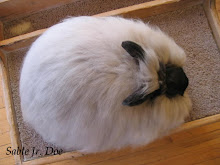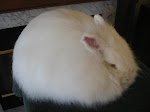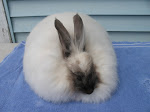--Another post from the old blog:
In addition to my favorite FA color, REW, I am also in love with all the Self colors:). Since I am not a spinner and don't get to see the effect of each color in yarn (which might make me prefer different ones, LOL), I breed for the colors that I think will make the biggest impact on the showtable OR are easiest to breed for uniformity and intensity of color. REW is an obvious choice for showing simply because there are very few DQs that a white rabbit can have (aside from crooked tails, teeth and actual physical deformities). Also, a White rabbit of almost any breed will always have greater wool/fur quality, yield, and density (for reasons that I'm not quite sure of that I will have to investigate in the future).
Self colors (IMO) are wonderful simply because they are stunning when bred for good intensity and there is nothing that distracts your eye away from the whole rabbit when it is on the showtable. A rabbit with a Broken pattern can sometimes appear to be "broken up" when posed, and your eye is likely to be drawn away from the wool and type of the rabbit to focus more strongly on the color pattern instead. (Btw, I do not mean to criticize the broken variety in any way, this is just an observation that I have made while at shows:) ).
The most dramatic Self color of all tends to be Black, for obvious reasons:). I have bred huge numbers of this color over the last several years but have kept very few because while they are stunning to behold in full coat, they can also be a nightmare to breed in terms of scattered white hairs/silvering, and other problems that occur. It is not that these problems emerge with less frequency in every other Self color (or any other variety for that matter), it is just that the Black variety is the opposite of White in that EVERY, TINY, little imperfection, spot, hair, and inconsistency shows up dramatically, and you see judges scrutinize this variety to no end simply because everything there is so obvious .
According to Glenna Huffmon's book, "Rabbit Coat Color Genetics" intensity of Color primarily has to do with Plus and Minus modifiers. On pg. 99 she says,
"The plus modifiers will produce larger areas of color, while the minus modifiers will enlarge and extend the areas of white. It all depends on the balance between the two factors. On a self-colored animal, no white is usually the ideal coloration-that is no small white spots and no scattered white hairs in the coat. However, with the presence of too many of the minus modifiers, the solid colored animal may show some white hairs or small white spots in the normally colored coat."
"The self-colored animal with 80% plus modifiers and 20% minus modifiers should still have a solid colored coat. Even 50% of each will usually result in a colored coat with no white. However, when the percentage of minus modifiers outnumbers the plus modifiers, such as 20% plus modifiers and 80% minus modifiers, those annoying white spots and hairs can show up. These white spots usually appear on the head, belly, chest, toes, and feet."
To correct white spots and hairs, she says,
"Breeders of rabbits with lilac and/or blue varieties are no doubt already aware of the modifiers that can result in more intense and darker coloration as opposed to those that lighten the basic color to a lighter shade. It takes a great deal of careful selective breeding on the rabbit breeder's part to get and keep the desired shade. These color intensifiers are not the result of just one gene. There needs to be a large number of them accumulated for them to have the desired affect on the final coat color. They cannot change the blue to black, but they can control the darkness or lightness of the blue color. It all depends on the ratio of dark to light modifiers present."
So in other words, each color is subjected to the effect of modifiers (most notably the Self varieties), but certain Selfs will more clearly express differences in intensity because they are a lighter color in general (Lilacs and Blues for ex.). Blacks and Chocolates will not necessarily get darker in overall body color, but you will see less of the stray white hairs and spots that plague these varieties and stand out so clearly.
I spoke with a number of breeders and read info. from several sources, and it appears that the best way to improve your Self colors and eliminate white hairs and spots is simply to cull out the rabbits who express them, breed only the best colored offspring, and breed like color to like color for as long as it takes to increase plus modifiers to the point where any trace of white in a rabbit's coat is eliminated. What I have done lately is to keep the best Blacks in my breedings that express few if any white hairs, and this year I will begin breeding them to each other in order to produce better bunnies of this variety and repeat the same color combination for several generations in a row.
* Quick note* A judge who didn't have much experience with Angoras recently told me that he thought most Angoras looked as though they had snips of white on their front feet. What I believe he was referring to was the fact that the footpads on a dark Angora variety like Black are light gray underneath and often 'push up between' the toes when the bunny is sitting, making it seem as though the feet have silver or white hairs on them. ALWAYS make certain that the color you are seeing is not really coming up from underneath a bunny's foot--- check your little toes carefully:).
*Also--the same principle applies to 'silvering' that can appear right beneath the bunny's nose (silver color, not white). White on TOP or anywhere around the nose can be a DQ but a 'silvery' (kind of faded black color) is normal on the upper lip of some darker color varieties (I see it regularly in my Blacks and Sables but they are never penalized for it at shows).
Also, I would like to mention in closing that there are other factors that can cause white spots/hairs in rabbits, and one of these is the Steel gene. Since I had quite a bit of Steel floating around in my lines it was entirely possible that the snips/hairs on the rabbits I had in the past was due in part to the presence of Steel, but at this point I choose to treat it as a modifier as I tackle the Steel gene at the same time using Torts, Pearls, and Fawns.
Anyhow, so this is a little bit about the color Black, one of my favorite colors aside from White, LOL. I may have missed info. here but will continue to do research as I go until I achieve the color quality I am looking for:).
Saturday, November 15, 2008
Subscribe to:
Post Comments (Atom)























1 comment:
Awesome work. Thanks for all the tips. Keep it up.
Post a Comment